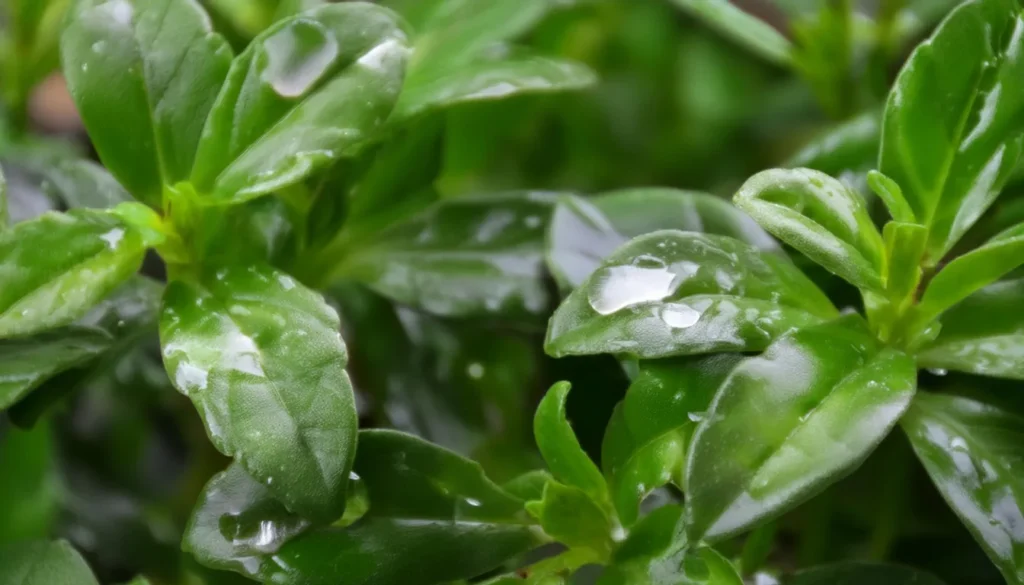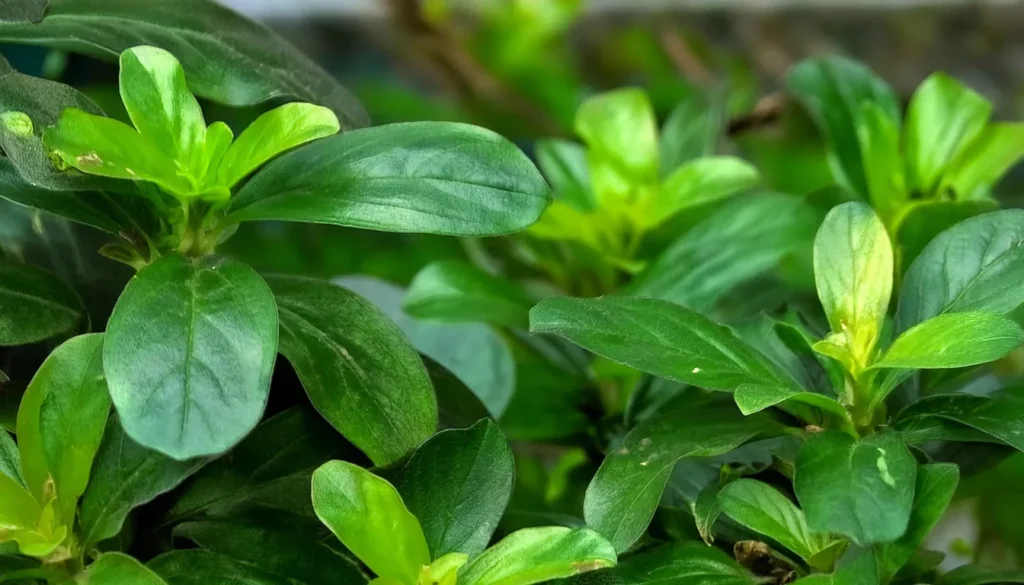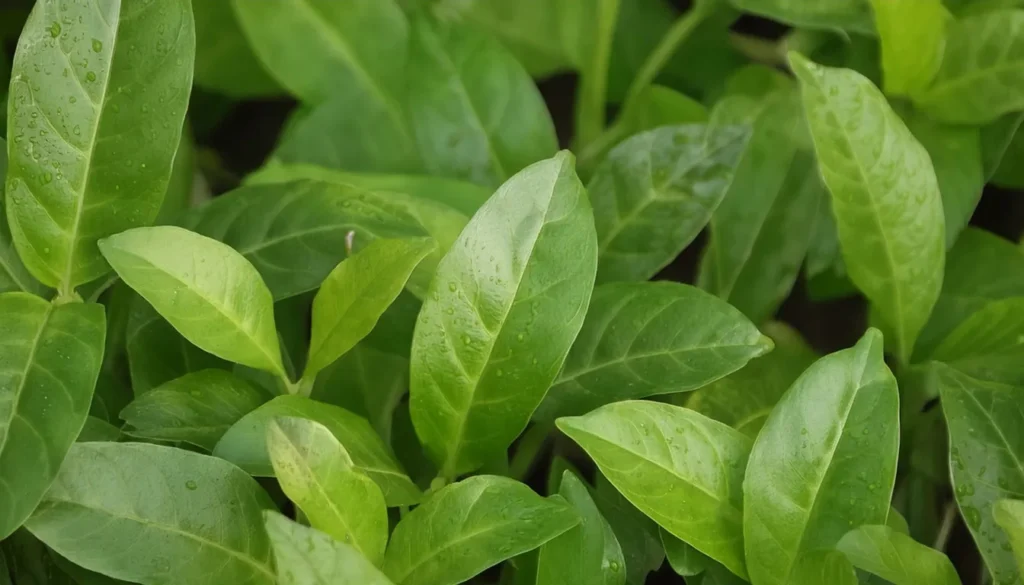As passionate aquarists, we understand the joy of creating a vibrant underwater oasis in our tanks. That’s why we’re excited to present this comprehensive guide to cultivating Staurogyne Repens, an exquisite aquatic plant that will elevate the beauty of your aquarium.
With its vibrant green foliage and low maintenance requirements, Staurogyne Repens is the perfect choice for both beginners and experienced hobbyists.
Staurogyne Repens, also known as the “carpeting plant,” is a versatile and captivating addition to any freshwater tank. Whether you’re an aquascaping enthusiast or simply want to enhance the aesthetics of your aquarium, this plant is sure to impress.
In this guide, we’ll dive into the history and natural habitat of Staurogyne Repens, explore optimal tank conditions, propagation techniques, care and maintenance tips, and discuss the different ways to use it as a carpeting plant or a stem plant.

With our expert advice and practical tips, you’ll learn how to create a thriving Staurogyne Repens aquascape that will be the envy of every aquarist.
So, let’s embark on this aquatic gardening journey together and unlock the secrets to a beautiful and vibrant underwater landscape.
Key Takeaway
- Staurogyne Repens is a vibrant aquatic plant with vibrant green foliage and low maintenance requirements.
- It can be used as a carpeting or stem plant, offering versatility in aquascaping designs.
- Understanding its natural habitat and optimal tank conditions is crucial for successful cultivation.
- Stem cutting and planting techniques are effective for propagating Staurogyne Repens.
- Regular monitoring and maintenance will ensure a healthy and thriving Staurogyne Repens aquascape.
Quick Stats
| Attribute | Details |
| Scientific Name | Staurogyne repens |
| Common Name | Staurogyne Repens |
| Origin | South America, specifically Brazil |
| Height | 3-10 cm (1.2-4 inches) |
| pH Range | 6.0 – 7.5 |
| CO2 Requirement | Low to Moderate |
| Growth Rate | Moderate to Fast |
| Care Level | Easy to Moderate |
| Color Form | Vibrant green |
| Water Conditions | 22-28°C (72-82°F), soft to moderately hard water |
| Max Size | Typically remains small, but can spread densely |
| Lighting | Moderate to High |
| Supplements | Minimal; may benefit from occasional liquid fertilization |
| Placement | Foreground to Mid-ground |
| Propagation | By stem cuttings or replanting runners |
What Is Staurogyne Repens?
Staurogyne Repens is a small stem plant native to South America. It belongs to the Acanthaceae family and is known for its hardy nature. This freshwater plant features vibrant green leaves and a slow but steady growth rate.
While it is often referred to as a carpeting plant, it is technically a stem plant. Staurogyne Repens is popular among aquarium enthusiasts due to its attractive appearance and low maintenance requirements.
History And Natural Habitat
Staurogyne Repens, a versatile aquarium plant belonging to the Acanthaceae family, originates from the Cristalino River in Mato Grosso, South America. In its natural habitat, it thrives on and between rocks along the fast-flowing river.
This freshwater plant has adapted to survive in various tank conditions, making it a popular choice among aquarists.
Physical Characteristics
- Stem Structure: Staurogyne repens is a stem plant, meaning it has a central stem from which leaves and roots grow. The stem is typically slender and can range in height depending on growing conditions and pruning.
- Leaves: The leaves of Staurogyne repens are oval to lanceolate in shape and arranged oppositely along the stem. They are relatively small, usually around 1 to 2 centimeters in length, and have a glossy or slightly textured surface. The color of the leaves can vary from bright green to reddish-green, depending on factors such as light intensity and nutrient availability.
- Leaf Texture: The leaves of Staurogyne repens may have a slightly serrated or wavy edge, adding texture to the plant’s appearance. This feature contributes to its aesthetic appeal and makes it a popular choice for aquascaping.
- Root System: Staurogyne repens develops a well-developed root system consisting of fine, white roots that anchor the plant into the substrate. Healthy roots are essential for nutrient uptake and overall plant health.

Lighting And CO2 Requirements
Lighting is crucial for the growth of Staurogyne Repens. Adequate lighting helps the plant photosynthesize and maintain vibrant foliage.
In addition to the recommended PAR range, it is essential to provide a consistent light schedule to mimic natural daylight. While Staurogyne Repens can survive without CO2 supplementation, adding CO2 can enhance growth and promote lush and compact foliage.
CO2 supplementation can be achieved through various methods, such as liquid CO2 or a CO2 injection system.
| Tank Conditions | Range |
| Temperature | 68-86°F |
| pH | 6.0-7.0 |
| Water Hardness (dGH) | 1-10 |
| Lighting | 30-50 PAR |
| Substrate | Nutrient-rich substrate or a mix of aquarium soil and gravel |
| CO2 | Supplementation recommended |
Temperature Parameters
- Temperature Range: Staurogyne repens thrives in tropical aquarium environments. The optimal temperature range for this plant is typically between 22°C to 28°C (72°F to 82°F).
- Stable Temperatures: While Staurogyne repens can tolerate minor fluctuations in temperature, it is essential to maintain stable water temperatures within the optimal range. Sudden or extreme fluctuations in temperature can stress the plant and hinder its growth.
- Winter Considerations: In colder climates or during the winter months, it’s important to ensure that the aquarium’s temperature does not drop below the lower end of the optimal range. Sudden drops in temperature can slow down growth or even cause damage to Staurogyne repens. Using a heater in the aquarium can help maintain stable temperatures during colder periods.
- Summer Heat: In warmer climates or during the summer months, monitor temperatures to prevent overheating. While Staurogyne repens can tolerate higher temperatures within the optimal range, excessively high temperatures can lead to stress and reduced growth. Adequate ventilation and cooling methods may be necessary to keep temperatures within the preferred range.

Optimal Water Condition
- Water Temperature: Maintain the water temperature within the range of 22°C to 28°C (72°F to 82°F). Staurogyne repens prefers tropical temperatures typical of freshwater aquariums.
- pH Level: Aim for a slightly acidic to neutral pH level, ideally between 6.0 to 7.5. Staurogyne repens can tolerate a moderate range of pH, but maintaining it within this optimal range ensures better nutrient availability and overall plant health.
- Water Hardness (GH): Staurogyne repens can adapt to a wide range of water hardness levels, but it generally prefers moderately soft to moderately hard water. Aim for a general hardness (GH) of 3 to 10 degrees dGH for optimal growth.
- Carbon Dioxide (CO2): Providing supplemental carbon dioxide (CO2) can enhance the growth of Staurogyne repens, especially in high-tech planted aquarium setups. CO2 supplementation promotes robust growth and vibrant foliage.
- Nutrient Levels: Staurogyne repens requires essential nutrients for healthy growth, including nitrogen (N), phosphorus (P), potassium (K), and micronutrients. Ensure that these nutrients are available in the water column through regular fertilization or substrate additives.
Substrate Requirement
- Substrate Type: Choose a substrate specifically designed for planted aquariums, such as aquatic plant substrate, aquarium soil, or nutrient-rich gravel. These substrates are specially formulated to provide essential nutrients for plant growth and support root development.
- Nutrient Content: Opt for a substrate with a rich nutrient content to promote healthy growth in Staurogyne repens. Look for substrates labeled as nutrient-rich or enriched with essential plant nutrients such as nitrogen, phosphorus, and potassium.
- Grain Size: Select a substrate with an appropriate grain size that allows for root penetration and prevents compaction. Fine-grained substrates like aquasoils or fine gravel are ideal for Staurogyne repens, as they provide a stable base for rooting while allowing water circulation and nutrient uptake.
- Depth: Provide an adequate substrate depth to accommodate the root system of Staurogyne repens. A depth of 2 to 3 inches (5 to 7.5 centimeters) is generally sufficient for most aquarium setups. Deeper substrates may be necessary for larger aquariums or to create sloping terrain.
Placement Options
- Foreground Plant: Staurogyne repens is commonly used as a foreground plant due to its low-growing habit and spreading nature. Plant it in the front of the aquarium to create a lush carpeting effect. Ensure that it receives adequate light and nutrients for healthy growth.
- Midground Plant: Alternatively, Staurogyne repens can be placed in the midground of the aquarium, where it can serve as a transition between foreground and background plants. This placement allows it to fill in empty spaces and create depth in the aquascape.
- Background Accent: Although Staurogyne repens is primarily used as a foreground or midground plant, it can also be used as a background accent in smaller aquariums or specific aquascaping layouts. Plant it in groups or clusters along the back of the aquarium to add texture and interest to the background.
- Aquascape Borders: Use Staurogyne repens to define borders or edges within the aquascape. Plant it along the edges of hardscape elements such as rocks or driftwood to soften hard lines and create a natural transition between different elements.

Recommended Tank Size
- Aquascape Layout: Consider the overall layout and design of your aquascape. If you plan to use Staurogyne repens as a foreground or midground plant in a small or medium-sized aquarium, a tank size of 10 to 20 gallons (38 to 76 liters) may be suitable. For larger aquascapes or if Staurogyne repens will be a focal point, consider larger tanks ranging from 20 to 50 gallons (76 to 189 liters) or more.
- Planting Density: Staurogyne repens can be planted densely to create a lush carpeting effect or spaced out for a more open and natural look. The tank size should accommodate the desired planting density and provide enough space for the plants to spread and grow.
- Compatibility: Consider the compatibility of Staurogyne repens with other aquatic inhabitants in the tank. If you plan to keep small fish, shrimp, or other invertebrates alongside Staurogyne repens, ensure that the tank size is suitable to accommodate their needs as well.
Suitable Tank Mates
- Small Fish: Choose peaceful and small fish species that won’t disturb or uproot Staurogyne repens. Examples include small tetras (e.g., neon tetras, ember tetras), rasboras, endlers, guppies, dwarf Corydoras catfish, and small species of livebearers.
- Shrimp: Many species of freshwater shrimp make excellent tank mates for Staurogyne repens. Cherry shrimp, Amano shrimp, and ghost shrimp are popular choices. Shrimp help keep the aquarium clean by scavenging for algae and detritus without damaging the plants.
- Snails: Certain species of freshwater snails can coexist peacefully with Staurogyne repens and contribute to the aquarium’s ecosystem. Nerite snails, Malaysian trumpet snails, and ramshorn snails are commonly kept in planted aquariums and help clean up algae and debris.
- Bottom Dwellers: Consider adding bottom-dwelling species that inhabit the substrate and won’t disturb the plants. Examples include small species of dwarf or pygmy corydoras, otocinclus catfish, and small loaches such as kuhli loaches.
- Peaceful Invertebrates: Various peaceful invertebrates can be compatible tank mates for Staurogyne repens. This includes freshwater clams, small crayfish species (e.g., dwarf crayfish), and certain species of freshwater crabs (e.g., Thai micro crabs) that won’t damage the plants.
RELATED: Cultivating Hemianthus Micranthemoides (Pearl Weed) For A Versatile Aquatic Oasis

Nutritional Needs
- Macronutrients: Staurogyne repens requires essential macronutrients for healthy growth, including nitrogen (N), phosphorus (P), and potassium (K). These macronutrients play crucial roles in various physiological processes such as photosynthesis, cell division, and enzyme activation.
- Micronutrients: In addition to macronutrients, Staurogyne repens also requires micronutrients or trace elements, including iron (Fe), manganese (Mn), magnesium (Mg), calcium (Ca), and others. These micronutrients are essential for enzyme function, chlorophyll synthesis, and overall plant health.
- Carbon Dioxide (CO2): Carbon dioxide is a critical nutrient for aquatic plants like Staurogyne repens as it serves as the primary carbon source for photosynthesis. In high-tech planted aquarium setups, supplementing CO2 can enhance plant growth and vitality.
- Light: Light is an essential factor for Staurogyne repens as it drives the process of photosynthesis. Provide moderate to high-intensity lighting for Staurogyne repens to ensure adequate light penetration and energy production.
Staurogyne Repens Cultivation Tips
- Lighting: Provide moderate to high-intensity lighting for Staurogyne repens to ensure adequate photosynthesis and growth. LED or fluorescent aquarium lights with a color temperature between 5000K to 7000K are suitable for promoting healthy plant growth.
- CO2 supplementation: Consider supplementing carbon dioxide (CO2) in high-tech planted aquarium setups to enhance it’s growth and vitality. CO2 injection promotes robust photosynthesis and helps prevent algae growth by encouraging plant growth.
- Nutrient-rich substrate: Use a nutrient-rich substrate specifically formulated for planted aquariums to provide essential nutrients for this plant. Alternatively, add root tabs or nutrient-rich substrate additives to ensure adequate nutrient availability for root uptake.
- Fertilization: Implement a regular fertilization regimen to supply this plant with essential nutrients. Choose a comprehensive liquid fertilizer or dry fertilizer regimen that provides macro and micronutrients required for healthy growth. Follow the manufacturer’s recommendations for dosing and application frequency.

Plant Propagation Tips
- Stem Cuttings: This plant can be propagated easily by taking stem cuttings from mature, healthy plants. Use sharp, clean scissors or aquascaping tools to trim stems from the parent plant. Cuttings should be at least a few inches long and include several nodes where leaves are attached.
- Preparation of Cuttings: Once you have taken stem cuttings, remove any leaves from the bottom portion of the stems to expose the nodes. These nodes are where new roots will develop. Trim any damaged or unhealthy-looking leaves from the cuttings.
- Planting Cuttings: Plant the stem cuttings into the substrate of the aquarium, ensuring that at least one node is buried in the substrate. You can use planting tweezers or your fingers to gently push the cuttings into the substrate. Space the cuttings apart to allow room for growth.
- Rooting Hormone (Optional): To encourage faster root development, you can dip the cut ends of the stem cuttings into a rooting hormone solution before planting them in the substrate. Rooting hormones contain auxins that stimulate root growth.
- Provide Optimal Conditions: After planting the cuttings, provide optimal growing conditions for root development. This includes providing adequate lighting, CO2 supplementation (if available), and regular fertilization to promote healthy growth.
Benefits Of Planting Staurogyne Repens
- Aquascape Aesthetics: Staurogyne repens features vibrant green foliage and a low-growing habit, making it an attractive addition to aquascapes. It forms dense carpets or bushy clusters, adding visual interest and enhancing the overall aesthetics of the aquarium.
- Natural Habitat Replication: It is commonly found in the wild in aquatic habitats, such as streams and rivers. By planting it in the aquarium, you can replicate the natural habitats of fish and other aquatic organisms, providing a more naturalistic and stimulating environment for them.
- Oxygenation: Like all aquatic plants, Staurogyne repens contributes to oxygenation of the aquarium water through photosynthesis. During daylight hours, the plant absorbs carbon dioxide and releases oxygen, helping to maintain healthy oxygen levels for fish and other aquatic inhabitants.
- Water Filtration: It helps improve water quality by absorbing nitrates, ammonia, and other pollutants from the water column. This natural filtration process helps to reduce algae growth and maintain a healthy aquatic ecosystem.
RELATED: Eleocharis Pusilla Guide For Proper Care, Tips & Growth

Conclusion
Cultivating it in your aquatic garden can provide a vibrant and low-maintenance addition to your tank.
By following the proper tank conditions, propagation techniques, and care and maintenance tips outlined in this guide, you can ensure the successful growth and thriving of Staurogyne Repens in your aquascape.
With its attractive appearance and versatility, This plant is an excellent choice for both beginner and experienced aquarists looking to create a lush and vibrant underwater landscape.
We hope this guide has provided you with a comprehensive understanding of this plant and its role in aquatic gardening.
By incorporating this beautiful plant into your aquarium, you can create a stunning aquascape that will be the envy of fellow hobbyists.
Remember to provide the proper tank conditions, propagate the plants using stem cutting and planting techniques, and monitor their health regularly.
Patience and dedication will reward you with a vibrant and thriving Staurogyne Repens aquascape.
Frequently Asked Questions
What Is Staurogyne Repens?
It is a popular aquatic plant known for its low maintenance requirements and vibrant green foliage. It is a small-stem plant native to South America and belongs to the Acanthaceae family.
What Are The Optimal Tank Conditions For Staurogyne Repens?
Optimal tank conditions for this plant include a temperature range of 68-86°F, pH level of 6.0-7.0, water hardness between 1-10 dGH, and medium to high lighting (30-50 PAR). It is recommended to use a nutrient-rich substrate and provide CO2 supplementation for optimal growth.
How Do I Propagate Staurogyne Repens?
It can be propagated using stem cutting and planting techniques. Underwater cultivation involves planting stem cuttings directly into the aquarium substrate, while emerged cultivation involves growing the plants above the water surface before transitioning them into the aquarium.
Can I Use Staurogyne Repens As A Carpeting Plant Or A Stem Plant?
Yes, it can be used as both a carpeting plant and a stem plant in aquascaping. It can be utilized in the aquarium’s foreground and midground areas to create stunning underwater landscapes.
How Do I Maintain A Healthy Staurogyne Repens Aquascape?
To maintain a healthy aquascape, it is important to regularly monitor plant health, trim excess growth, perform water changes, and address any signs of distress or nutrient deficiencies. Weekly maintenance tasks can help keep the aquascape vibrant and thriving.
- Unveiling The Wonders Of Riccia Fluitans In Aquascapes - August 7, 2024
- Vallisneria Gigantea Var. Guide To Care And Cultivation At Home - July 31, 2024
- Vesicularia Dubyana Care & Growth Guide Tips For Beginner Gardeners - July 30, 2024
